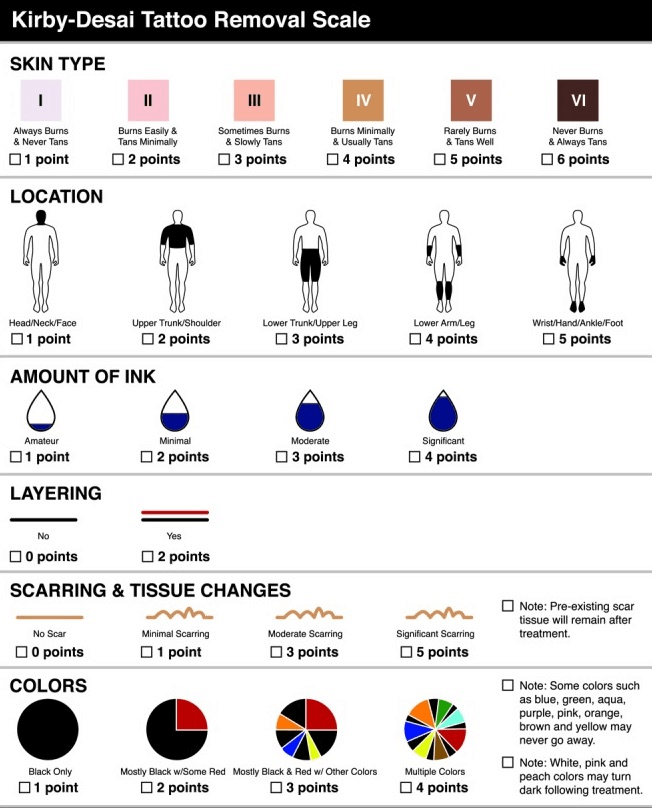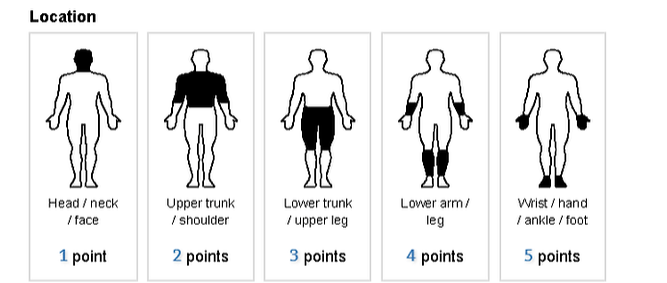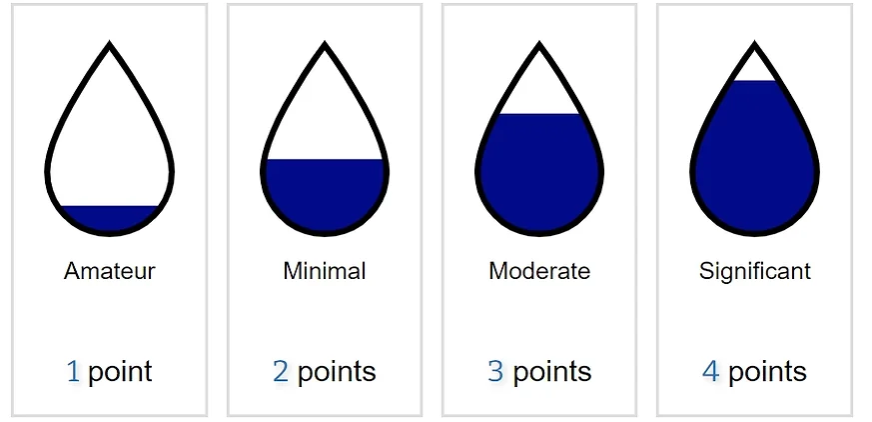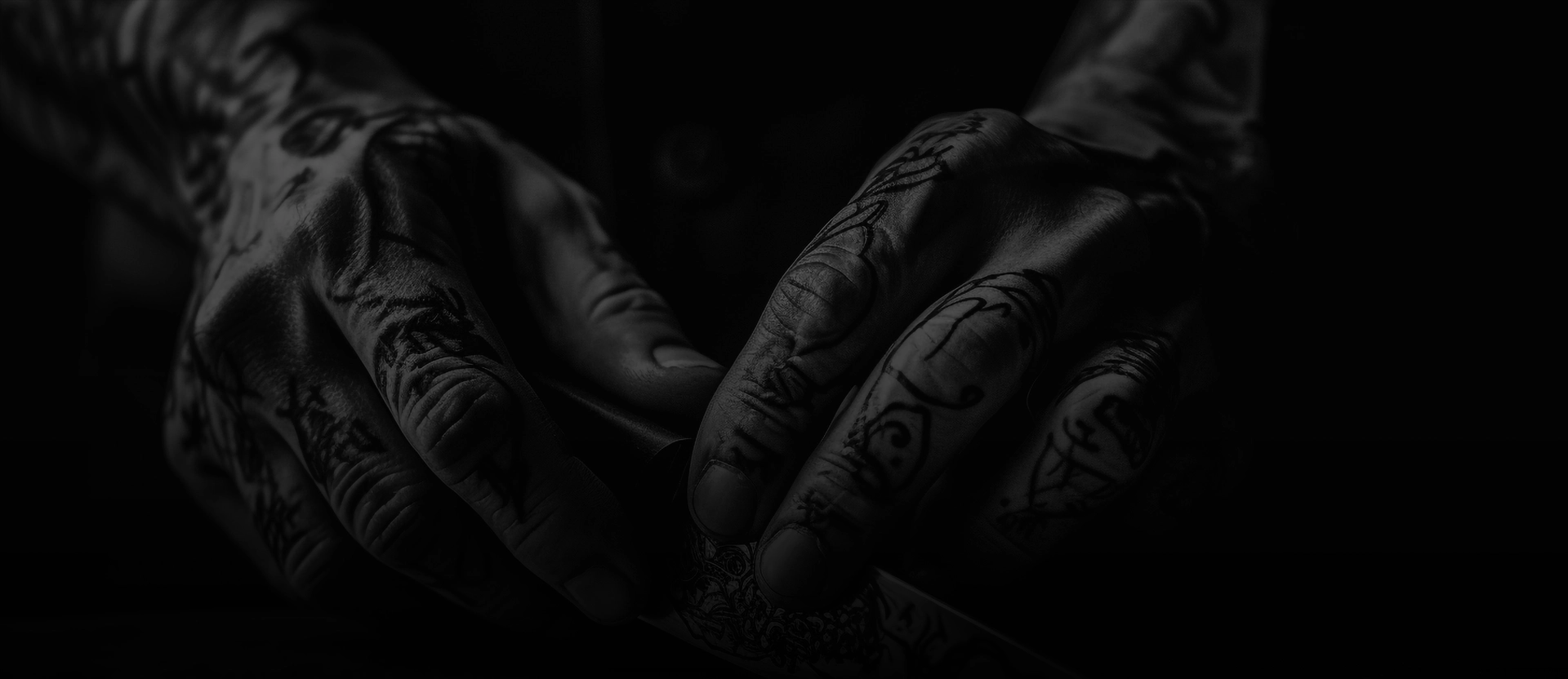There is a simple way to estimate the number of sessions needed for tattoo removal. The time interval between sessions is approximately 4 to 6 weeks. The resulting score, roughly at 80%, represents the number of sessions needed – for example, a score of 10 points indicates 8 to 12 sessions. Below the image, you will find an explanation of the individual factors. All images are in English and will enlarge when clicked.

Skin Tone
Darker skin tones may require more sessions for laser tattoo removal, as they require a higher wavelength to avoid the risk of scarring.

Scar Tissue (depends on tattoo artist's skill)
Depending on the tattoo artist’s technique, some tattoos leave more scar tissue than others, even if it is not visible to the naked eye. Tattoos are harder to remove from scarred areas. Tattoos can sometimes cause complications, leading to increased collagen buildup in the skin and resulting in scars. Tissue damage varies according to individual skin types. Excessive scarring and tissue changes can make it more difficult for the laser to penetrate the area, complicating the tattoo removal process.

Tattoo Location
The location on the body can affect the speed of laser tattoo removal. Areas of the body with a high density of blood vessels and lymph nodes, such as the face, neck, upper, and lower back, are treated more easily. Hands and feet also respond well – but as you move toward extremities like hands and feet, tattoo removal progresses more slowly.
The location of the tattoo affects the speed of removal. The closer the tattoo is to the extremities, the more sessions may be required.

Tattoo Color
Contrary to what you might expect, black ink is usually the easiest to remove. Some colored inks, particularly red and green, are more difficult to remove with traditional laser therapies. However, the PicoSure® Pro Laser we use is a leading global technology for tattoo removal and works effectively on colored inks as well.

Amount of Ink in the Skin
The amount of ink within a tattoo is another factor affecting the success and duration of laser tattoo removal. The difference in ink depends on the type of tattoo the patient has. Professional tattoos tend to have denser ink than amateur tattoos. Therefore, tattoo removal takes longer for professional tattoos compared to amateur ones.

Number of Tattoo Layers - Cover-Up
Many patients attempt to remove unwanted tattoos by covering them up or adding new tattoos over existing ones. Laser tattoo removal on a covered-up tattoo will remove the new tattoo and reveal the old one. Additional treatments are needed to successfully remove ink from a combined or cover-up tattoo.
Other Factors Affecting the Duration and Quality of Tattoo Removal
- Tattoo Size - The larger and more complex the tattoo, the more sessions you will need for laser removal. The treatment itself is very quick – the laser acts on the ink immediately – but the larger the tattoo, the longer each session will be, and more sessions will likely be required.
- Tattoo Age - As a tattoo ages, it becomes “buried” deeper into the skin, so some may appear slightly faded over time. Generally, the newer the tattoo, the faster it will be removed.
- Ink Depth - This also relates to the skill of the tattoo artist. Professional tattooists tend to use more ink and penetrate slightly deeper into the dermis compared to amateur artists. The deeper the ink is embedded in the skin, the longer it will take to remove.
- Immune System Strength - The PicoSure® Pro Laser we use works by creating pressure waves that break the tattoo ink into microscopic particles, which are then expelled by the body’s natural process.
- Smoking - Research suggests that smoking may reduce the effectiveness of laser tattoo removal. However, studies have focused on older Q-Switched technologies rather than the PicoSure® Pro technology used here at FADE, which is the most advanced available. It appears that smoking may compromise results and suppress the immune system, so it is best to avoid smoking if possible.
- Sun Exposure - Laser tattoo removal cannot be safely performed on sunburned skin, and for safety during treatment, we recommend avoiding sun exposure as much as possible. Where unavoidable, it is advised to use high SPF sunscreen or cover the treated area.
- Laser Type - Several types of laser technologies are used for tattoo removal. Traditional Q-Switched lasers are among the most common and may take approximately 10-20 sessions to achieve good results. With the new PicoSure® Pro laser – which we exclusively offer – you can expect up to 75% faster and more complete tattoo removal compared to traditional lasers. Traditional lasers heat the ink in your tattoo and break it into small pieces, but the patented PressureWave™ technology of the PicoSure® Pro laser breaks the ink into tiny particles that your body can more easily eliminate.
-
Tattoo Ink Type and Quality - Tattoos vary not only in design but also in the type and composition of ink used. The good news is that the PicoSure® Pro Laser we use is the most effective available worldwide and is highly effective in removing dark or pre-modified inks.

